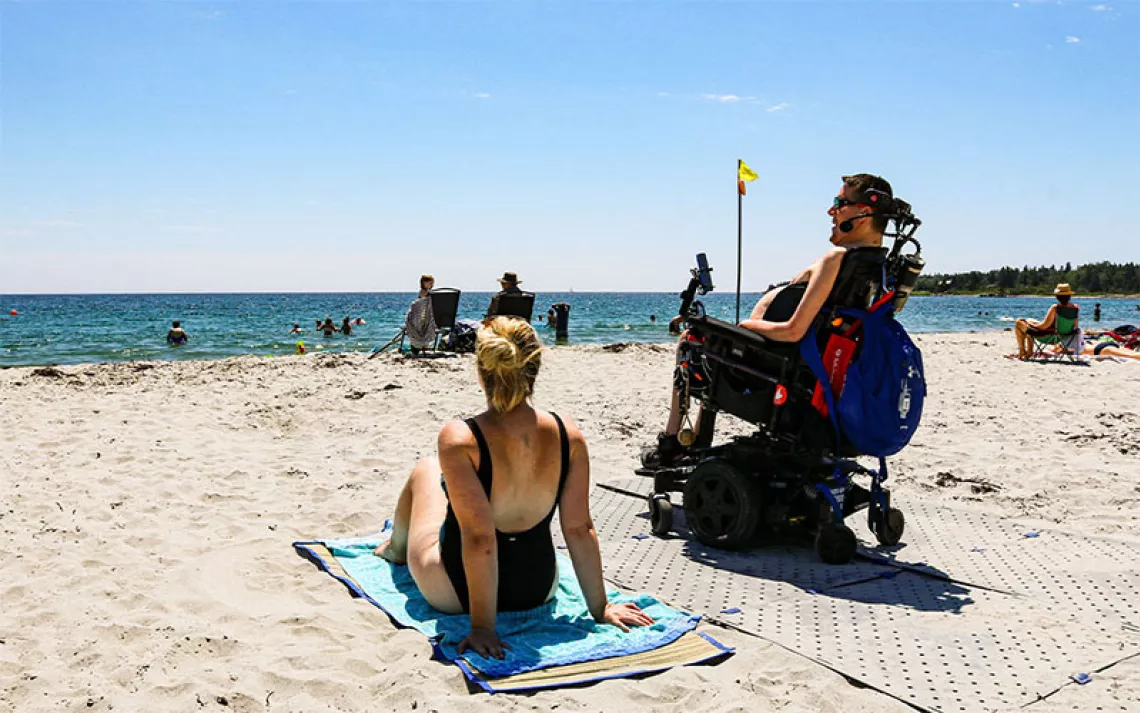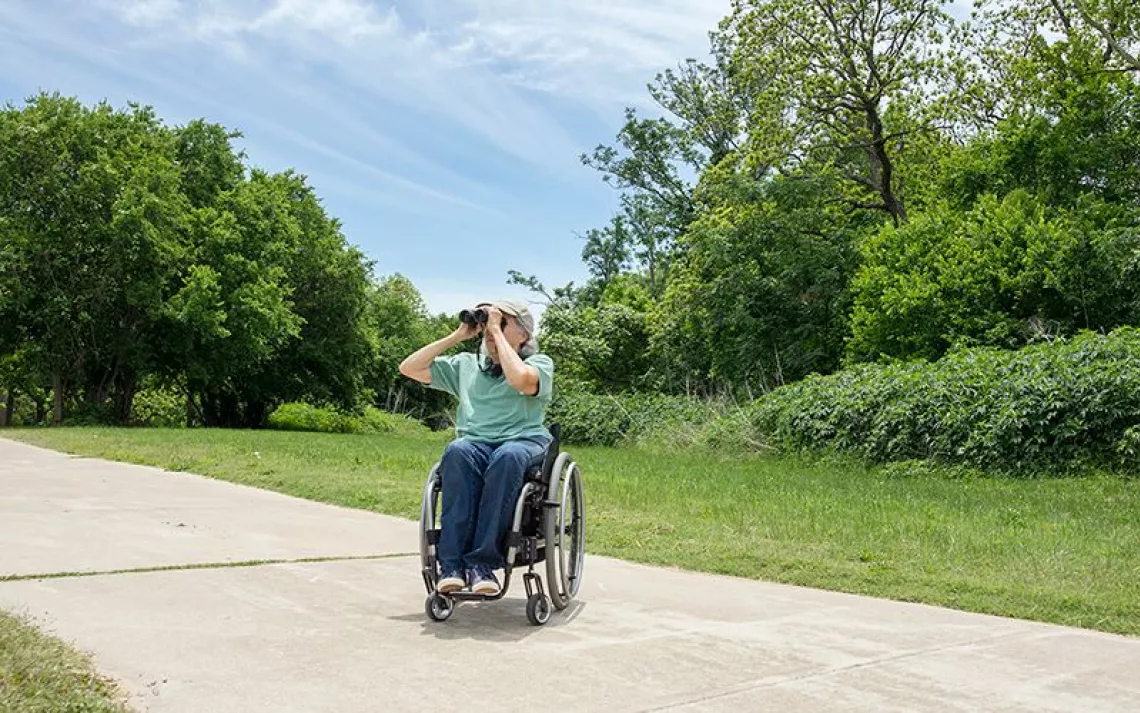A Burgeoning Movement Improves Outdoor Accessibility for the Blind
Inside braille trails, sensory gardens, and more
Whether he’s hiking in his beloved White Mountains or ascending a distant peak, Randy Pierce pays attention with all of his senses. He listens to the wind as it whistles through a ravine or rustles in a stand of American beech trees. He lets the fragrance of the forest, as it becomes dominated by pine, tell him when he’s reached an elevation milestone. With one hand on a trekking pole and the other on his guide dog’s harness or a friend’s backpack, Pierce feels the ground and focuses on the shifts in his partners’ movements to anticipate roots or rocks in his path. Even the air on his face provides clues about his environment, he says. “People who have been blind all their life are better at it than me, but … I can walk along and I can feel when I am close to a massive tree because the air pressures change, or I can feel when I’m close to a glacial erratic because of the temperature change.”
At the summit, Pierce visualizes the sweeping views his companions describe, relishing in the fact that he gets to “see” such vistas through multiple sets of eyes. And on cloudy days, he can often tell those same friends what would be in their sightline if the skies were clear. That’s because he prepares for hikes by tracing raised relief maps with his thumb while listening to descriptions of the landscapes.
Although an estimated 32.2 million adults in the US identify as blind or unable to see, or experience difficulty seeing even with corrective lenses, many nature-based experiences remain difficult to access for blind and partially sighted individuals.
Some of these barriers are physical. Nature-based experiences often require venturing into geographically isolated places, which of course becomes especially difficult for individuals who depend on public transportation. And once there, people who are blind or partially sighted may grapple with additional challenges, says Christopher Dixon, youth program manager at the Center for the Visually Impaired in Daytona Beach, Florida. Seemingly simple endeavors like navigating new terrain or finding a trailhead can be tricky in the absence of accessible information.
“If you haven’t had proper mobility training at that location, where do you go, how do you get around, what’s there, where are things?” Dixon says. “It’s hard to get there, and once you get there, it’s hard to get around if you haven’t been there before.”
Some of this is changing. Across the country, networks of "braille trails" include educational placards in braille, guide lines to delineate the path, and tactile walkways or smartphone-accessible audio tours. "Sensory gardens" explicitly take the experience beyond the visual, incorporating plants that make strange sounds, have unique scents, are appealing to touch, or can be tasted. In recent years, the National Park Service has added audio guides and brochures at dozens of its parks and is slowly working toward improving transit options in some areas.
Still, even with some concrete obstacles out of the way, personal and interpersonal obstacles continue to keep many blind and partially sighted people from embracing the outdoors. Megan O’Connell-Copp is an adaptive physical education teacher at Perkins School for the Blind in Watertown, Massachusetts. As she introduces her students to sports and outdoor activities, she finds many of them have “internalized others’ perceptions of their limitations.”
After Pierce lost his vision at 22—the result of a neurological disease—he quit hiking and climbing for nearly 20 years. It wasn’t until his condition worsened, temporarily landing him in a wheelchair, that he started to think about the outdoors again. As he worked with a physical therapist to regain his ability to walk, she sought out creative ways to challenge and inspire him. One day, she encouraged him to try using a hiking stick in place of the more stable quad-cane.
In 2009, four years after he began the process of getting his feet back under him, Pierce was hiking again, in earnest. By August 2013, he had summited all 48 of New Hampshire’s 4,000-foot peaks in both winter and summer and had his sights on adventures from the Grand Canyon to Kilimanjaro.
For youths who, unlike Pierce, may not have fond memories of wilderness adventures to motivate them, innovative programs are still opening doors. In 2016, Perkins unveiled an accessible park adjacent to the school, along the banks of the Charles River. The paved path, marked by a guide wire and dotted with braille markers at points of interest—such as the sensory garden or canoe-shaped benches—gives students the chance to explore independently and with multiple senses.
In central Florida, the Young Sound Seekers program, started earlier this year, introduced a group of blind and partially sighted students—most of whom had never been to a national park—to the soundscapes of Canaveral National Seashore. The NPS-funded program is a collaboration between the Atlantic Center for the Arts, Daytona Beach's Center for the Visually Impaired, and Stetson University. It aims to give the youths a real-life opportunity to hone practical skills, such as navigating unfamiliar ground, and introduces them to nature in their own backyards.
At its core, Young Sound Seekers teaches students to “interrogate” their environments using sound. At the program’s second in-person meeting on a Saturday this past September, the group gathered in the shade of the live oak canopy at Seminole Rest, listening to bird calls, squirrels scrambling among the branches, a breeze whispering through the moss, even a jet rumbling overhead. Guided by Stetson professor of digital arts and music technology Nathan Wolek, participants described what they heard and discussed the role that sounds play in the ecosystem. In a modified version of the National Park Service’s “Time Machine” exercise, they imagined what it might have sounded like when the Indigenous Timucuan people were shucking oysters and tossing the shells into the area’s nascent middens 3,000 years ago.
Using senses other than vision is fundamental to the way blind and partially sighted people experience the world, Dixon explains. “We use our hands and our fingers to look and see and feel,” he says, adding, “Listening is just another tool for understanding what’s beyond our fingertips.”
Thus, expanding nature-based resources in ways that showcase an array of sensory experiences is an essential part of making those spaces more welcoming to individuals who are blind or partially sighted. It’s also an important way, in our visually oriented culture, to expand how typically sighted visitors perceive the outdoors.
 The Magazine of The Sierra Club
The Magazine of The Sierra Club



